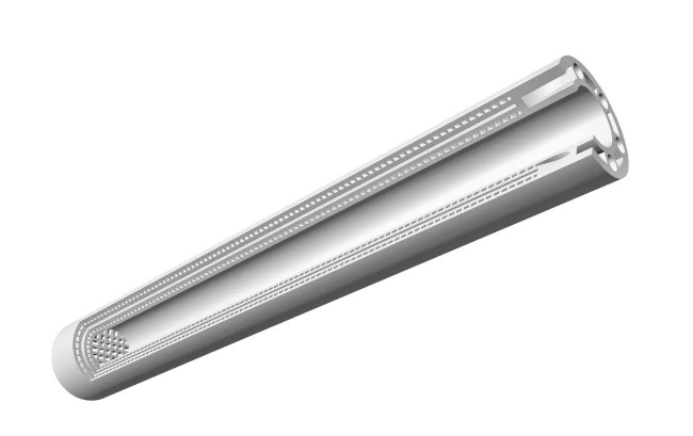Bosch recently partnered with The Karlsruhe Institute of Technology (KIT) and BASF to create the world’s first technical ceramic 3D printed microreactor. This first-of-its-kind microreactor plans to aid German chemical giant BASF in understanding its chemical reactions with more precision than before, potentially offering insights into chemistry that have yet to be gained.
Technical ceramics, also known as advanced or engineered ceramics, have been around since 1902 and are widely used throughout society. Their properties can easily be tuned to a specific application by changing the chemical composition or manufacturing process. These properties include the ability to withstand high temperatures, exhibit high hardness, and display excellent insulation. This makes them very attractive materials to use, and it’s no wonder why many companies are exploiting these benefits.
 Cross sectional render of a 3D printed technical ceramic microreactor. (Source: Bosch Advanced Ceramics)
Cross sectional render of a 3D printed technical ceramic microreactor. (Source: Bosch Advanced Ceramics)For this reason, an ideal application for these materials can be found in microreactors. Traditionally, it has been difficult to machine the small and intricate internal structures a microreactor truly needs. As a result, these devices offer limited control over temperature and the material flow within. Additive manufacturing (AM), therefore, presents a novel solution. By 3D printing a microreactor with complex internal structures, it would be possible to obtain better insights into chemical reactions more quickly.
 Image inside a Bosch ceramic 3D printer from Lithoz. (Source: Bosch Advanced Ceramics)
Image inside a Bosch ceramic 3D printer from Lithoz. (Source: Bosch Advanced Ceramics)Limited by off-the-shelf ceramic microreactors, BASF sought the aid of Bosch’s Advance Ceramics Division and KIT. 3D printing allowed them to build the complex internal structures needed and do it at a size (0.5 mm minimum channel width) that would allow BASF researchers to accurately monitor and control the chemical reactions within. After many trials, the team successfully created a process to manufacture the world’s first 3D-printed technical ceramic microreactor.
The first device is now being used by BASF to study its chemical reactions under ideal conditions. So far, the device is working better than BASF expected, and the company already has plans to order 10-20 more from Bosch. If this new microreactor continues to show promise, it could glean valuable new insights that wouldn’t be possible with the current technology.
We would love to see how this partnership proceeds in the future and just how small channels can be made. If channel size is the limiting factor, then the group could find a way to shrink channel size further while keeping the costs of new microcreactors reasonable. Every lab needs better equipment, and BASF isn’t the only company interested in understanding chemical reactions better. Bosch may have just opened up a whole new market niche for ceramic 3D printing.
Subscribe to Our Email Newsletter
Stay up-to-date on all the latest news from the 3D printing industry and receive information and offers from third party vendors.
You May Also Like
3D Printing Unpeeled: New Arkema Material for HP, Saddle and Macro MEMS
A new Arkema material for MJF is said to reduce costs per part by up to 25% and have an 85% reusability ratio. HP 3D HR PA 12 S has been...
3D Printing News Briefs, January 20, 2024: FDM, LPBF, Underwater 3D Printer, Racing, & More
We’re starting off with a process certification in today’s 3D Printing News Briefs, and then moving on to research about solute trapping, laser powder bed fusion, and then moving on...
3D Printing Webinar and Event Roundup: December 3, 2023
We’ve got plenty of events and webinars coming up for you this week! Quickparts is having a Manufacturing Roadshow, America Makes is holding a Member Town Hall, Stratafest makes two...
Formnext 2023 Day Three: Slam Dunk
I’m high—high on trade show. I’ve met numerous new faces and reconnected with old friends, creating an absolutely wonderful atmosphere. The excitement is palpable over several emerging developments. The high...































